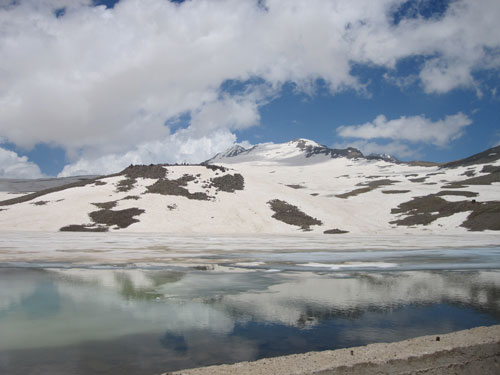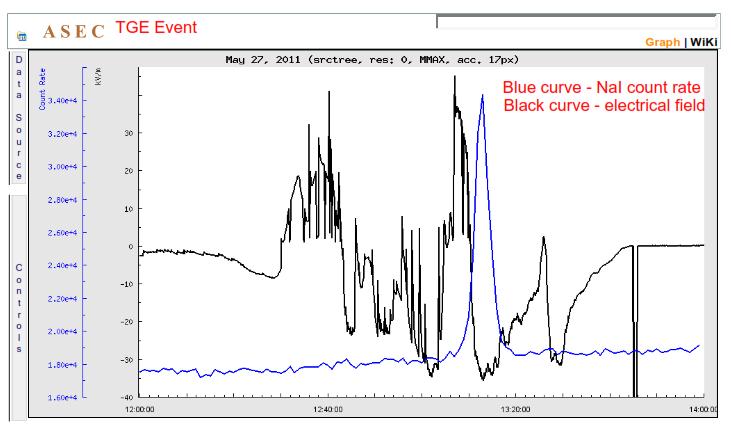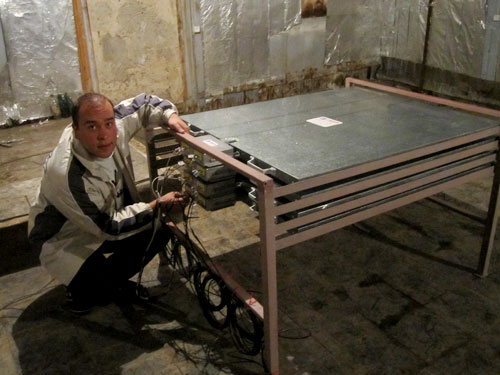
| 2011-03-06 07:45:36 |
New particle detectors installed at Aragats for precise measurement of the Thunderstorm Ground Enhancement (TGEs)
After the road to Mt.
Aragats in the end of May was opened (see Figure 1, soon the ice on the lake adjacent to detector building will melt) CRD
physicists have installed 2 new networks of the particle detectors.

Figure 1. Lake "Kari" 3200 m a.s.l., June 17, 2011, ice is melting
The first network
consists of 5 NaI large crystals of 30 *12.5 * 12.5 cm size and one reference
plastic scintillator of the same size. NaI crystals have very high efficiency
for the gamma ray detection and, fortunately, the network detected the first
huge TGE event of 2011 just on the first day of operation, see Figure 2.

Figure 2. Time series of the electrical field and Nal count rates
NaI crystals demonstrate ~100% count rate excess at the moment of the large negative electrical field
between thundercloud and ground and intensive negative intercloud lightning
occurrence.
Other particle outdoor detectors (5 cm thick plastic scintillators) located nearby demonstrate 10 times less enhancement ~10%. NaI network is also sensitive to short particle bursts, discovered last year at Aragats (see details in Chilingarian et al., 2010)
Other particle outdoor detectors (5 cm thick plastic scintillators) located nearby demonstrate 10 times less enhancement ~10%. NaI network is also sensitive to short particle bursts, discovered last year at Aragats (see details in Chilingarian et al., 2010)

Figure 3. Electronic engineer Davit sargsyan assembling the STAND3 detector
On June 16 another system of detectors, namely, STAND3, was installed in the same hall as NaI
network. The new detector is sensitive to the charged particles. The detector
has 4 energy thresholds and is well suited to measure energy spectrum of the electrons
from the Relativistic Runaway Electron Avalanches (RREA). RREA is a very rare
event and only on September 19, 2009 we detected huge enhancement of the
electron flux (see details in Chilingarian et. al., 2010) allowing us measure for
the first time the energy spectrum of the RREA electrons.
References
A. Chilingarian, A.Daryan, K.Arakelyan, et al., Ground-based observations of thunderstorm-correlated fluxes of high-energy electrons, gamma rays, and neutrons, Phys.Rev. D., 82, 043009, 2010
A. Chilingarian, G. Hovsepyan, and A. Hovhannisyan, Particle bursts from thunderclouds: Natural particle accelerators above our heads, Physical review D 83, 062001 (2011)
A. Chilingarian, A.Daryan, K.Arakelyan, et al., Ground-based observations of thunderstorm-correlated fluxes of high-energy electrons, gamma rays, and neutrons, Phys.Rev. D., 82, 043009, 2010
A. Chilingarian, G. Hovsepyan, and A. Hovhannisyan, Particle bursts from thunderclouds: Natural particle accelerators above our heads, Physical review D 83, 062001 (2011)
